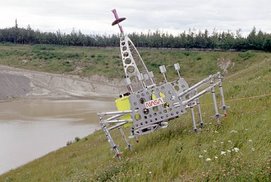
Researchers are working on the creation of robotic ward assistants to cope with staff shortages
Experts from universities in the UK, France, Germany, Italy, Ireland, Spain and Turkey are working on a multi-million pound research project to cure the ever-increasing problem of hospital staff shortages.
The project, dubbed IWARD, kicked off at the beginning of this month and, if all goes well could potentially see these robotic nurses and other clinical assistants milling about in hospitals and healthcare centres as early as 2010.
Having secured £1.8 million (€2.7 million) in European Union (EU) funding, the consortium of institutions, which includes Cardiff, Dublin, Newcastle and Warwick in the UK, aim to create a 'robot swarm' to help attend to patients' needs more quickly and effectively as well as reducing costs and ensuring cleanliness to minimise the likelihood of Methicillin-resistant staphylococcus aureus (MRSA) transmission.
"IWARD will mean that hospital staff will be able to spend more time with their patients rather than doing other basic tasks," project leader Thomas Schlegel, from the human-computer interaction division at the Fraunhofer Institute in Germany, said in an interview with The Engineer.
"The idea is not only to have mobile robots, but a full system of integrated information terminals so that the hospital is full of interaction and intelligence. Operating as a completely decentralised network means that the robots can co-ordinate things between themselves, such as deciding which one would be best equipped to deal with a spillage or to transport medicine."
The robo nurses will be capable or identifying people or things in need of attention and attending to those patients or items. By equipping the robots with different adaptable hardware components, they will also be able to perform a wide range of other tasks such as floor cleaning and delivery of food, linen and medicine.
A suite of inbuilt cameras and sensors will ensure the robots can navigate their way around buildings as well as avoiding collision with fellow robots and other objects.
If a collision with an electronic counterpart is imminent, the robots will be able to warn one another using wireless technology such as Bluetooth.
The aim is to have three working prototype robots by the end of the three-year project.







No comments:
Post a Comment